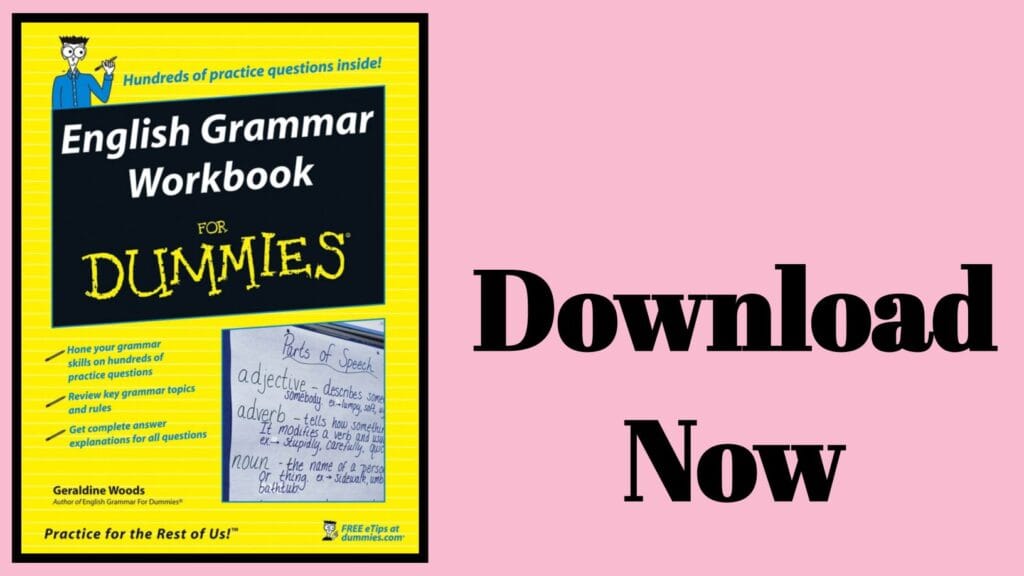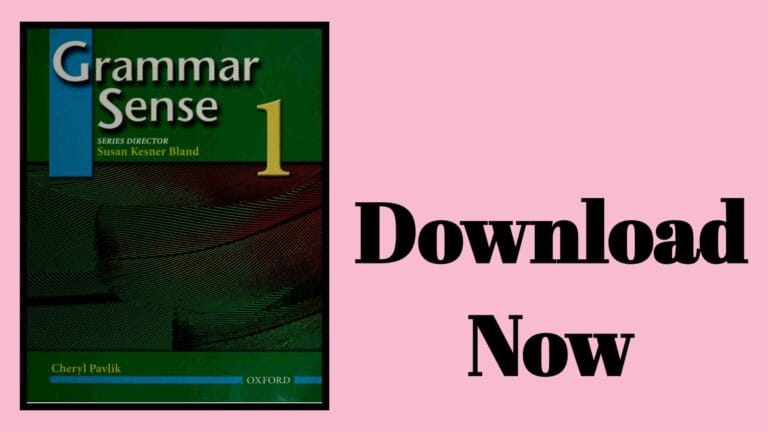
The Book Description
The name of the book “English Grammar Workbook for Dummies” suggests that the book is written keeping in mind its targeted readers who are, according to the author ” dummies” of the English language. The new starters who have just started focusing on learning the grammars and rules of English.
Thus, the book covers all the essential and relevant English grammar topics that are must read ones when starting the journey of learning English grammar. Thereupon, the author has made sure to talk about the unavoidable topics grammar through his unique teaching style and engaging contents.
Who Is This Book For?
The term, “dummies” in the name of the book “English Grammar Workbook for Dummies” hints at who this workbook is written for. The book then is ideal for those learners of English language who are looking for an easy to understand grammar guide book to start learning the rules and grammars of the English language. Therefore, if you’ve just started out with the grammar, then this book is what you should go with.
Why Add This Book to Your Reading List?
It’s really important to note that you need to go through the contents of the grammar book that you’re going to self study in order to make sure that what you need has been discussed in great details in it. Thus, you should be looking for some certain features of the book. Here’s why you should prefer this book to read:
- Unique Style of Teaching: the author of the book has made sure to maintain his unique and easy to pick up style of teaching in the book. The author goes like this: he first talks about definition of a grammar topic such as past tense then gives examples and then puts up several questions related to the topic.
- Question Based Teaching: The author uses one of the best techniques to teach his readers grammar topics through a question based teaching. The writer makes sure that you just do not learn the concepts but you put into practice what you’ve just learned from the chapter.
- All Important Topics: In the book, the author has ensured to include all the necessary grammar topics so that you do not need to go with another book for other topics. The book, therefore, is an all inclusive one which covers all the topics and rules of English grammar that are required to prepare you a good speaker in English.
Table of Contents
Introduction
About This Book
Conventions Used in This Book
What You’re Not to Read
Foolish Assumptions
How This Book Is Organized
Part I: Laying Out the Concrete Slab: Grammar Basics
Part II: Mastering Mechanics
Part III: The Pickier Points of Correct Verb and Pronoun Use
Part IV: All You Need to Know about Descriptions and Comparisons
Part V: Writing with Style
Part VI: The Part of Tens
Icons Used in This Book
Where to Go from Here
Part I: Laying Out the Concrete Slab: Grammar Basics
Chapter 1: Placing the Proper Verb in the Proper Place
Choosing among Past, Present, and Future
Shining a Light on Not-So-Perfect Tenses
Navigating among Irregular Forms
Mastering the Two Most Common Irregulars: Be and Have
Getting By with a Little Help from Some Other Verbs
Calling All Overachievers: Extra Practice with Verbs
Answers to Problems on Verbs and Verb Tenses
Chapter 2: Matchmaker, Make Me a Match: Pairing Subjects and Verbs Correctly
When One Just Isn’t Enough: Plural Nouns
Isn’t Love Groovy? Pairing Subjects and Verbs
Taming the Brats: Difficult Subjects to Match with Verbs
Calling All Overachievers: Extra Practice with Hitching Subjects and Verbs
Answers to Subject and Verb Pairing Problems
Chapter 3: Who Is She, and What Is It? The Lowdown on Pronouns
Separating Singular and Plural Pronouns
Taking Possession of the Right Pronoun
It’s All in the Details: Possessives versus Contractions
Avoiding Double Meanings
Calling All Overachievers: Extra Practice with Basic Pronouns
Answers to Pronoun Problems
Chapter 4: Finishing What You Start: Writing Complete Sentences
Seeking Out the Subject/Verb Pair
Checking for Complete Thoughts
Going for Flow: Joining Sentences Correctly
Finishing with Flair: Choosing Endmarks
Complete or Incomplete? That Is the Question
Calling All Overachievers: Extra Practice with Complete Sentences
Answers to Complete Sentence Problems
Part II: Mastering Mechanics
Chapter 5: Exercising Comma Sense
Making a List and Checking It Twice
You Talkin’ to Me? Direct Address
Dating and Addressing
Introducing (and Interrupting) with the Comma
Setting Off Descriptions
Calling All Overachievers: Extra Practice with Commas
Answers to Comma Problems
Chapter 6: Made You Look! Punctuation Marks That Demand Attention
Connectors and Dividers: Hyphens
Just Dashing Through
Sorting Out Semicolons
Placing Colons
Calling All Overachievers: Extra Practice with Hyphens, Dashes, Colons, and Semicolons
Answers to Punctuation Problems
Chapter 7: One Small Mark, a Whole New Meaning: Apostrophes
Putting Words on a Diet: Contractions
Taking Possession
Calling All Overachievers: Extra Practice with Apostrophes
Answers to Apostrophe Problems
Chapter 8: “Let Me Speak!“ Quotation Marks
Lending Written Words a Voice: Punctuating Direct Quotations
Embedding One Quotation inside Another
Punctuating Titles
Calling All Overachievers: Extra Practice with Quotation Marks
Answers to Quotation Problems
Chapter 9: Hitting the Big Time: Capital Letters
Bowing to Convention and Etiquette: People’s Names and Titles
Entering the Worlds of Business and Academia
Capitalizing Titles of Literary and Media Works
Placing Geographical Capitals
AM or p.m.? Capitalizing Abbreviations
Calling All Overachievers: Extra Practice with Capital Letters
Answers to Capitalization Problems
Part III: The Pickier Points of Correct Verb and Pronoun Use
Chapter 10: The Case of It (And Other Pronouns)
Meeting the Subject at Hand and the Object of My Affection
To “Who” or To “Whom”? That Is the Question
Linking Up with Pronouns in “To Be” Sentences
You Talkin’ to Me, or I? Pronouns as Objects of Prepositions
Matching Possessive Pronouns to “-ing” Nouns
Calling All Overachievers: Extra Practice with Pronoun Case
Answers to Pronoun Case Problems
Chapter 11: Choosing the Best Pronoun for a Tricky Sentence
Nodding in Agreement: Pronouns and Possessives Come Head to Head
Working for the Man: Pronouns for Companies and Organizations
Decoding Who, That, and Which
Getting Down to Specifics: Avoiding Improper Pronoun References
Calling All Overachievers: Extra Practice with Tricky Pronoun Situations
Answers to Advanced Pronoun Problems
Chapter 12: Traveling in Time: Tricky Verb-Tense Situations
Telling Tales of the Past
The Unchanging Universe: When You’re Stuck in the Present
Tackling the Timeline: Verbals to the Rescue
Calling All Overachievers: Extra Practice with Verb Tenses
Answers to Advanced Verb Tense Problems
Chapter 13: Are You and Your Verbs in the Right Mood?
Stating the Obvious: Indicative Mood
Taking Command: Imperative Mood
Telling Lies or Being Passive: Subjunctive Mood
Calling All Overachievers: Extra Practice with Moody Verbs
Answers to Verb Mood Problems
Part IV: All You Need to Know about Descriptions and Comparisons
Chapter 14: Writing Good or Well: Adjectives and Adverbs
Distinguishing between Adjectives and Adverbs
How’s It Going? Choosing between Good/Well and Bad/Badly
Mastering the Art of Articles
Calling All Overachievers: Extra Practice with Descriptors
Answers to Adjective and Adverb Problems
Chapter 15: Going on Location: Placing Descriptions Correctly
Little Words Mean a Lot: Situating “Even,” “Only,” and Similar Words
It Must Be Here Somewhere! Misplaced Descriptions
Hanging Off a Cliff: Dangling Descriptions
Dazed and Confused: Vague Descriptions
Calling All Overachievers: Extra Practice Placing Descriptions
Answers to Description Placement Problems
Chapter 16: For Better or Worse: Forming Comparisons
Visiting the -ER (And the -EST): Creating Comparisons
Going from Bad to Worse (And Good to Better): Irregular Comparisons
Words That Are Incomparable (Like You!)
Calling All Overachievers: Extra Practice with Bad Comparisons
Answers to Comparison Problems
Chapter 17: Apples and Oranges: Improper Comparisons
No One Likes to Feel Incomplete, and Neither Do Comparisons
Being Smarter than Yourself: Illogical Comparisons
Double Trouble: A Sentence Containing More than One Comparison
Calling All Overachievers: Extra Practice with Improper Comparisons
Answers to Complicated Comparison Problems
Part V: Writing with Style
Chapter 18: Practicing Parallel Structure
Geometry Invades English: Parallelism Basics
Avoiding Unnecessary Shifts in Tense, Person, and Voice
Matchmaking 101: Either/Or, Not Only/But Also, and Similar Pairs
Calling All Overachievers: Extra Practice with Parallels
Answers to Parallelism Problems
Chapter 19: Spicing Up and Trimming Down Your Sentences
Beginning with a Bang: Adding Introductory Elements
Smoothing Out Choppy Sentences
Awkward but Interesting: Reversed Sentence Patterns
Shedding and Eliminating Redundancy
Calling All Overachievers: Extra Practice Honing Your Sentences
Answers to Sentence Improvement Problems
Chapter 20: Steering Clear of Tricky Word Traps
Separating Almost-Twins: Commonly Confused Words
Comparing Quantities without Numbers
Sorry to Bust Your Bubble, but Some Common Expressions Are Wrong
Verbs That Will Give You a Headache
Combining Rightfully Independent Words
Calling All Overachievers: Extra Practice with Tricky Words
Answers to Tricky Word Problems
Part VI: The Part of Tens
Chapter 21: Ten Overcorrections
Substituting “Whom” for “Who”
Inserting Unnecessary “Had’s”
Throwing in “Have” at Random
Sending “I” to Do a “Me” Job
Speaking or Writing Passively
Making Sentence Structure Too Complicated
Letting Descriptions Dangle
Becoming Allergic to “They” and “Their”
Being Semi-Attached to Semicolons
Not Knowing When Enough Is Enough
Chapter 22: Ten Errors to Avoid at All Cost
Writing Incomplete Sentences
Letting Sentences Run On and On
Forgetting to Capitalize “I”
Being Stingy with Quotation Marks
Using Pronouns Incorrectly
Placing New Words in the Wrong Context
Letting Slang Seep into Your Speech
Forgetting to Proofread
Relying on Computer Checks for Grammar and Spelling
Repeating Yourself
Appendix: Grabbing Grammar Goofs
Exercise One
Exercise Two
Exercise Three
Exercise Four
Answers to Exercise One
Answers to Exercise Two
Answers to Exercise Three
Answers to Exercise Four
Index
Summary: English Grammar Workbook for Dummies
In conclusion, the book “English Grammar Workbook for Dummies” is a book on English grammar especially designed for the beginner learners of the English language that they can use to hone their grammar skills through hundreds of practice questions that have been crafted intentionally to check your understanding of the book chapter that you’ve just completed reading.
The key grammar topics and rules such as parts of speech, modal verbs, tenses, voices, narrations, conditional sentences, wish clauses, sentence structures, etc., have been covered in great details in a unique and easy to understand manner through its beautifully and amazingly crafted contents.
The most appealing part of the book is that the writer does not only put up hundreds of grammar questions and provides answers to them but also elucidate the answers with clear explanations along with them. This way, you first try to recall what you’ve extracted from the book, then look at the answers and explanations provided against them.


